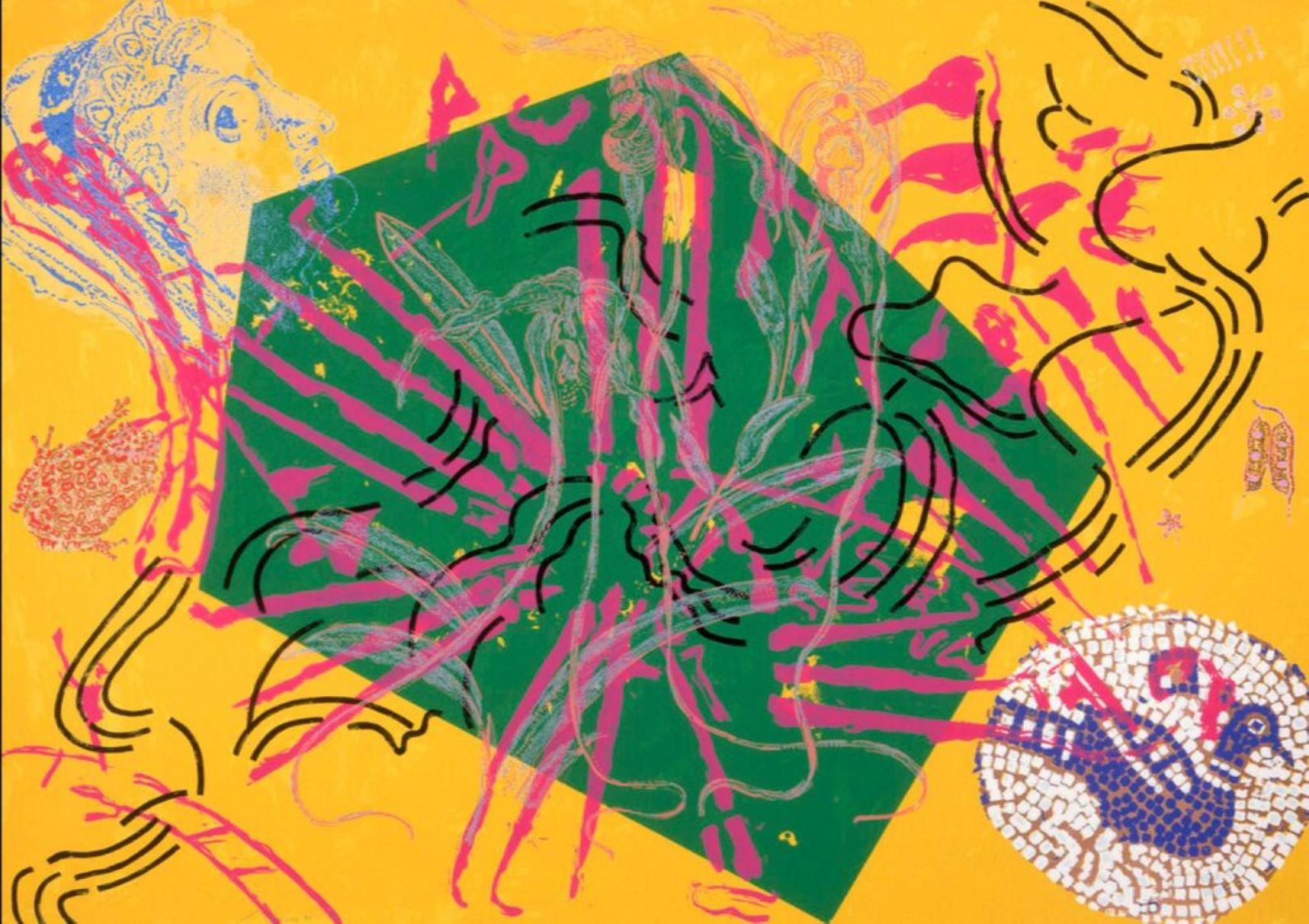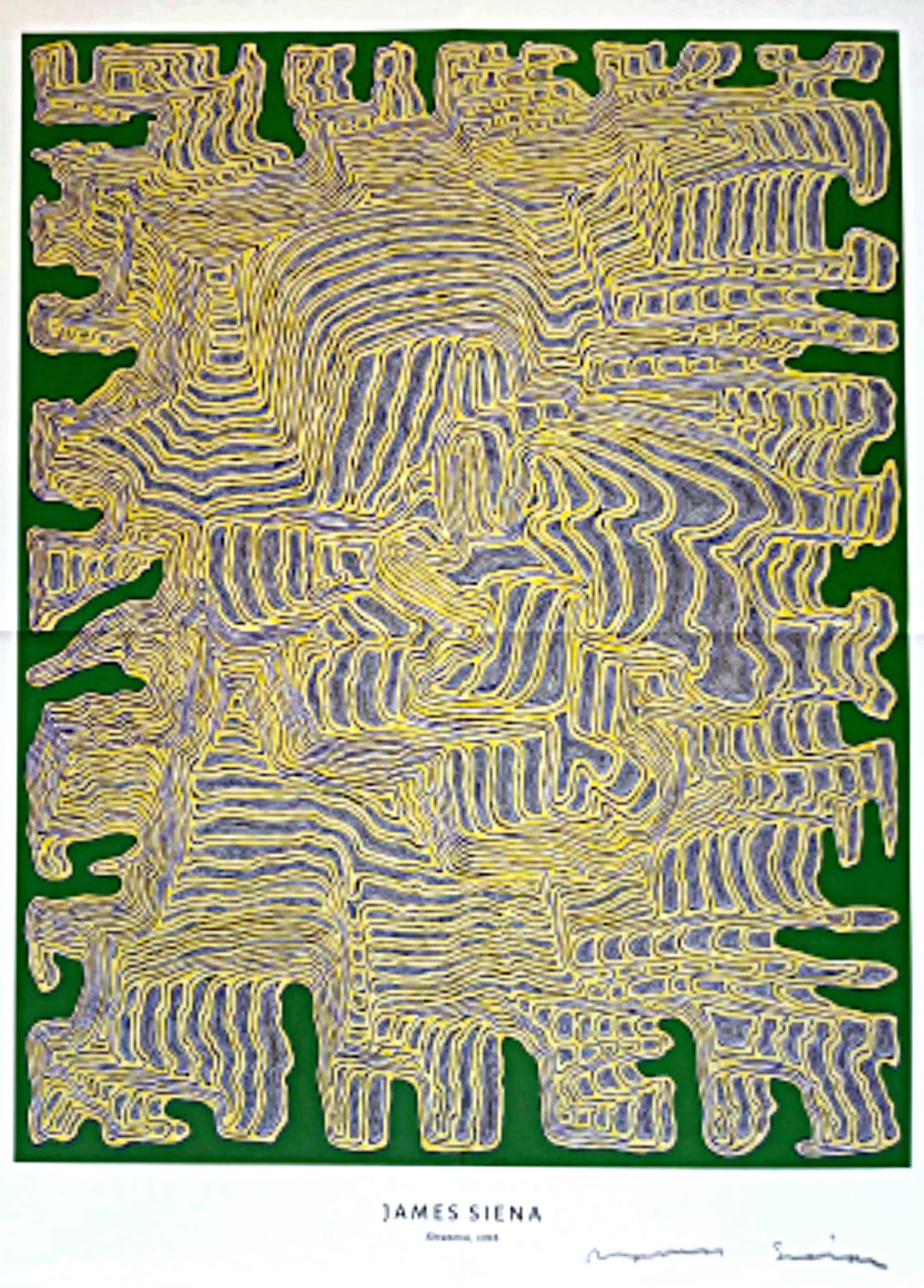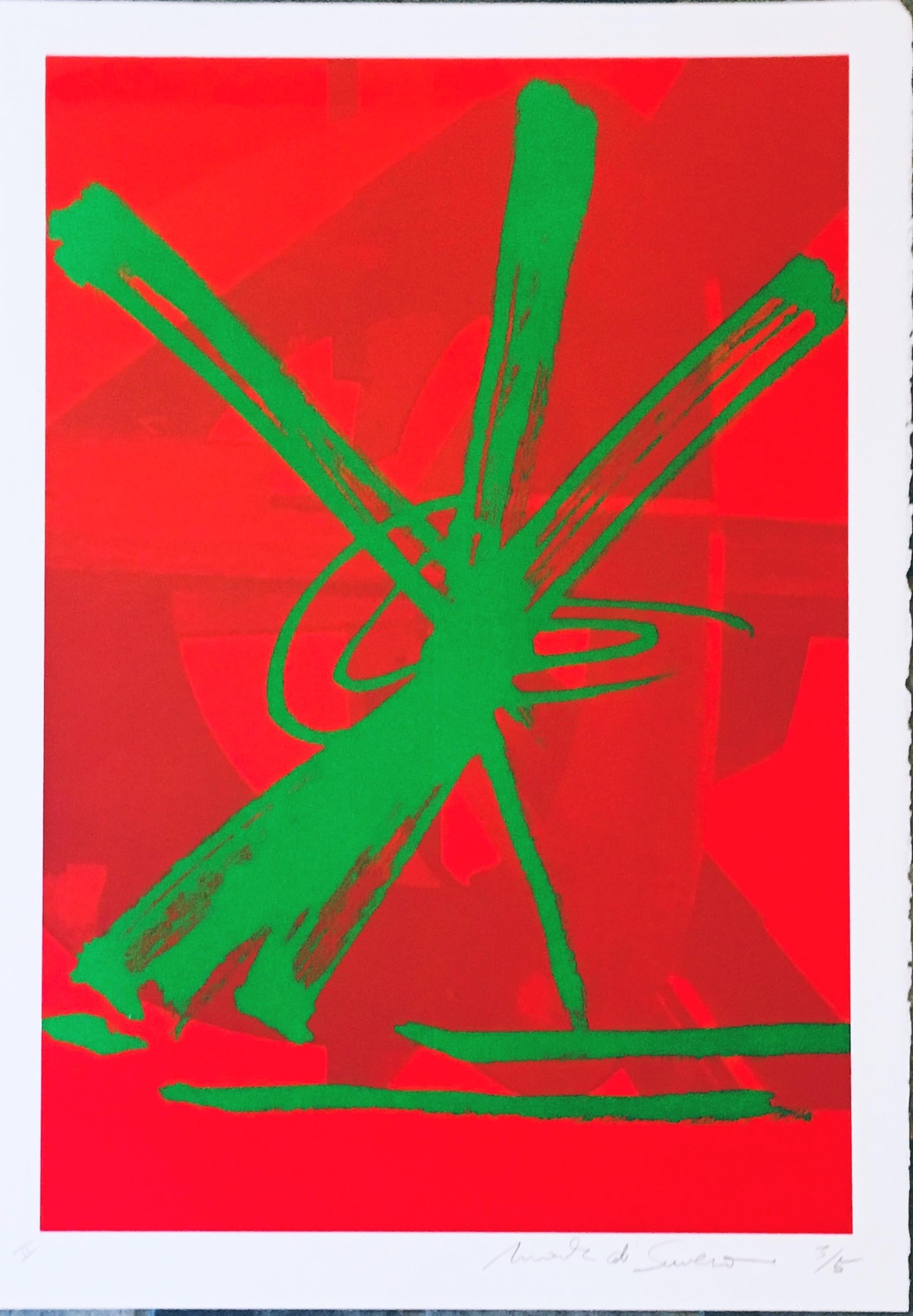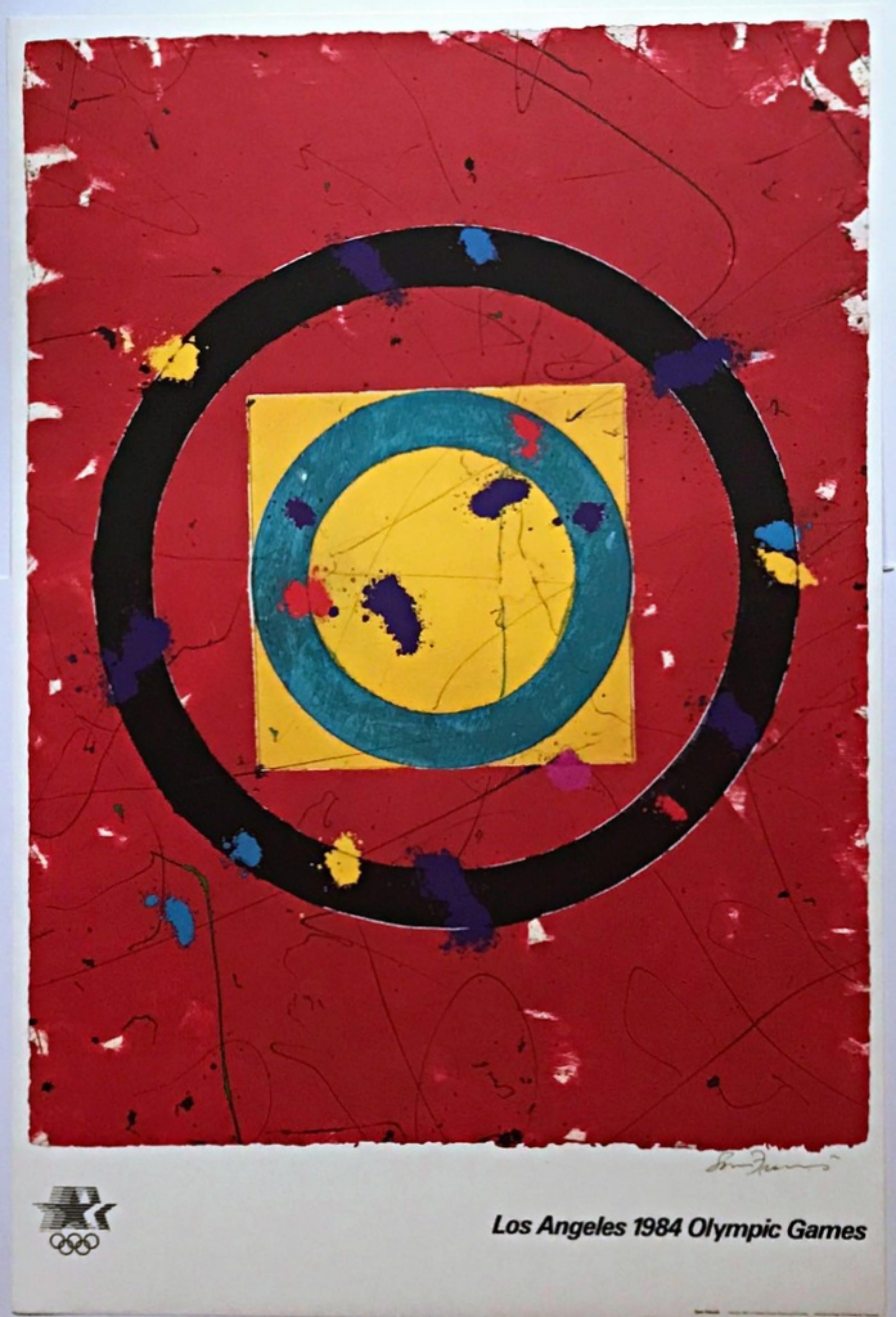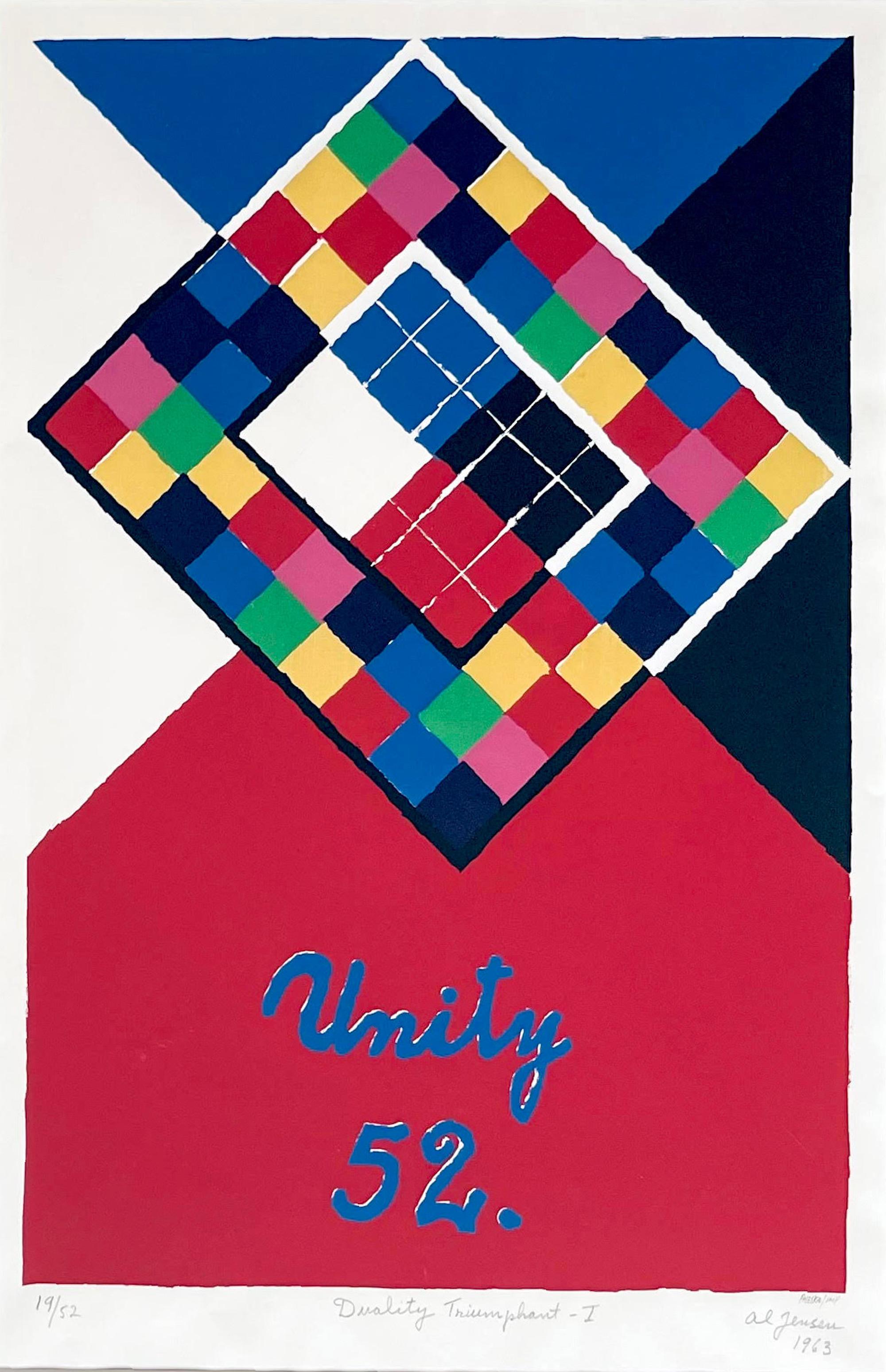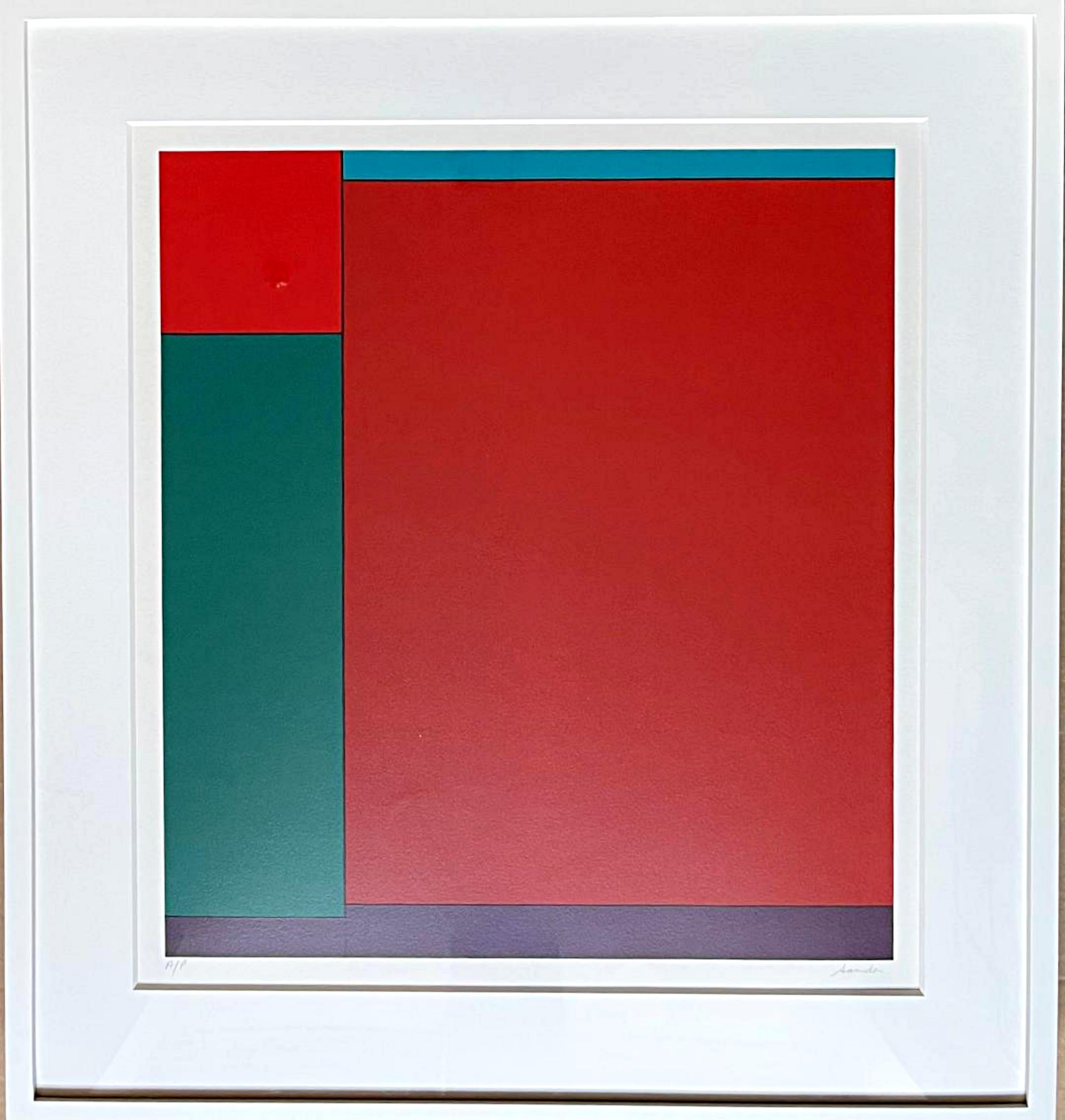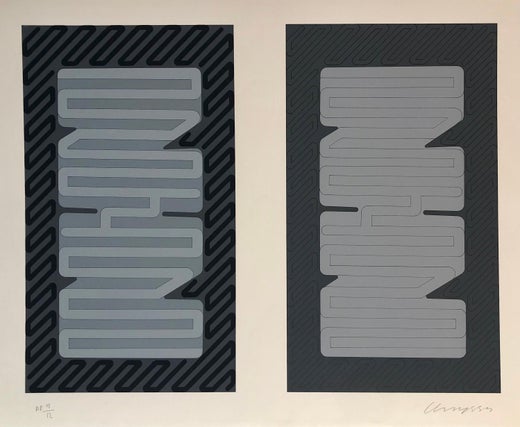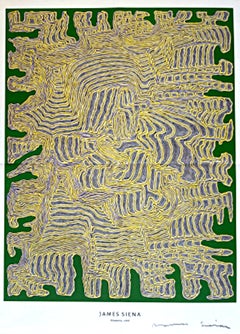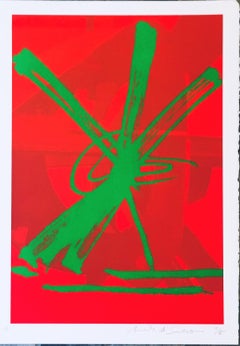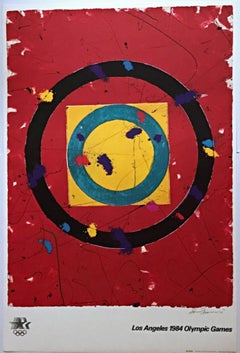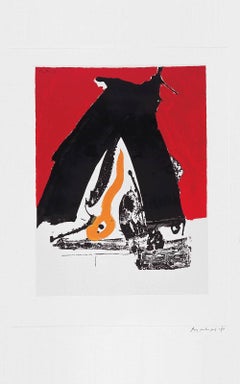Items Similar to Chinatown Portfolio II Plate Three Signed Silkscreen Large 40 x 38" Greek artist
Want more images or videos?
Request additional images or videos from the seller
1 of 5
Chryssa Vardea-MavromichaliChinatown Portfolio II Plate Three Signed Silkscreen Large 40 x 38" Greek artist1978
1978
About the Item
Chryssa
Chinatown Portfolio II, Plate Three, ca. 1978
Silkscreen on thick wove paper
40 × 30 1/2 inches
(Ships rolled in a tube measuring 35 x 5 x 5)
Pencil signed and numbered 36/150 on the front; bears printers stamp on the back
Unframed
from the Chinatown Portfolio
Printed by Atelier Arco in Paris (with stamp on the back of the print)
from the Chinatown Portfolio
Renowned Greek-American artist Chryssa was preoccupied with the concept of Chinese letters as art forms, which she explores in her Chinatown silkscreen series. Her deliberate experimentations yield an elegant and compelling result.
Chryssa Biography
Chryssa Vardea-Mavromichali was a Greek-born American sculptor best known for her monumental assemblages combining neon, bronze, aluminium, plaster, wood, canvas and paint as well as found objects, which prefigured both pop art and minimalism. Vardea studied in Paris and San Francisco, and in 1955 moved to New York, finding inspiration in the spectacle of the advertising neon signs of Times Square. Her interest in communication and the use of letters was first expressed through small baked-clay tablets entitled Cycladic Books 1955, followed by tablets and plaques with single letters, or variations on letter forms. Using neon since 1962, Vardea was one of the first artists to transform it from an advertising tool into an art material.
It was the same interest in the written word that inspired Chryssa Vardea’s most ambitious, monumental work, The Gates to Times Square (also known as ‘The Gates’), which was realised between 1964 and 1966. The work is Vardea’s homage to her experience of New York, to popular culture, advertising and mass communication. Consisting of two monumental letter As, incorporating fragments of commercial signs, the just under one-metresquare stainless steel, Plexiglas and neon sculpture invites visitors to walk through it, becoming physically immersed in the pale blue neon light with changing intensity and rhythm. Study for Gates No. 4 1967 is one of sixteen sculptures entitled Studies for Gates, which the artist produced both before and after the completion of the main work itself. The work takes a fragment of the monumental work, resembling the letter S, repeating it sixteen times, in eight double sets of blue neon
- Creator:Chryssa Vardea-Mavromichali (1933 - 2013, Greek)
- Creation Year:1978
- Dimensions:Height: 35 in (88.9 cm)Width: 5 in (12.7 cm)Depth: 5 in (12.7 cm)
- Medium:
- Movement & Style:
- Period:
- Condition:Unframed; never framed; gentle and unobtrusive handling.
- Gallery Location:New York, NY
- Reference Number:1stDibs: LU174529861032
Chryssa Vardea-Mavromichali
Chryssa, (born Chryssa Vardea Mavomichali) is best known for her "Luminist" sculpture in brilliantly colored neon tubing, was born in Greece and now ranks as one of the outstanding and innovative artists in America today. Chryssa has had individual and collective exhibition shows at the Museum of Modern Art, The Guggenheim, The Whitney -New York. Harvard University; Institute of Contemporary Art at the University of Pennsylvania; Carnegie Institute among many others.
About the Seller
5.0
Platinum Seller
Premium sellers with a 4.7+ rating and 24-hour response times
Established in 2007
1stDibs seller since 2022
408 sales on 1stDibs
Typical response time: 1 hour
- ShippingRetrieving quote...Shipping from: New York, NY
- Return Policy
Authenticity Guarantee
In the unlikely event there’s an issue with an item’s authenticity, contact us within 1 year for a full refund. DetailsMoney-Back Guarantee
If your item is not as described, is damaged in transit, or does not arrive, contact us within 7 days for a full refund. Details24-Hour Cancellation
You have a 24-hour grace period in which to reconsider your purchase, with no questions asked.Vetted Professional Sellers
Our world-class sellers must adhere to strict standards for service and quality, maintaining the integrity of our listings.Price-Match Guarantee
If you find that a seller listed the same item for a lower price elsewhere, we’ll match it.Trusted Global Delivery
Our best-in-class carrier network provides specialized shipping options worldwide, including custom delivery.More From This Seller
View All5745, for the Jewish Museum original signed/n abstract expressionist screenprint
By Nancy Graves
Located in New York, NY
Nancy Graves
5745, for the Jewish Museum, 1984
Silkscreen on paper
Signed, numbered 5/90 and dated in graphite pencil on the front; bears publishers' blind stamp front left corner
30 1/4 × 40 1/2 inches
Unframed
Commissioned by the Mr. and Mrs. Albert A. List Graphic Fund for The Jewish Museum, New York
Signed, numbered and dated in graphite pencil on the front; bears publishers' blind stamp front left corner. Commissioned by the Mr. and Mrs. Albert A. List New Year's Graphic Fund for The Jewish Museum, New York. During the 1980s, various artists were commissioned to create a print celebrating the Jewish New Year. This is the silkscreen renowned sculptor Nancy Graves created to celebrate the year 5745 of the Jewish Calendar, beginning in September 1984 (Rosh Hashanah). This work was published in a limited edition of 90. The number 90 has special significance in Jewish gamatria (numerology) for several reasons, including the fact that it equals five times life - or Chai. The number for Chai, meaning "Life " s 18, and 18 x 5 = 90. This is a magical number in Judaism. All of the works were published in editions that were multiples of 18, or the Life. In her lifetime, Nancy Graves did not receive the renown or acknowledgement that her ex-husband and former Yale School of Art classmate Richard Serra did, but she is finally getting the recognition she richly deserves.
Biography: Nancy Graves (1939 – 1995) is an American artist of international renown. A prolific cross-disciplinary artist, Graves developed a sustained body of sculptures, paintings, drawings, watercolors, and prints. She also produced five avant-garde films and created innovative set designs.
Born in Pittsfield Massachusetts, Graves graduated from Vassar College in 1961. She then earned an MFA in painting at Yale University in 1964, where her classmates included Robert Mangold, Rackstraw Downes, Brice Marden, Chuck Close, as well as Richard Serra with whom she was married from 1964 to 1970. Five years after graduating, her career was launched in 1969 when she was the youngest artist — and only the fifth woman — to be selected for a solo presentation at the Whitney Museum of Art. Graves’ work was subsequently featured in hundreds of museum and gallery exhibitions worldwide, including several solo museum exhibitions. She was awarded commissions for large-scale site-specific sculptures and her work is in the permanent collections of major art museums. A frequent lecturer and guest artist, her work was widely documented during her lifetime. In 1991 she married veterinarian Dr. Avery Smith. Graves travelled extensively and was fully engaged with the cultural and intellectual issues of her times. Her brilliant career and life were cut short by her untimely death from cancer at age 54.
From a point of view that she described as “objective,” Graves transformed scientific sources, such as maps and diagrams, into artworks by re-producing their complex visual information in detailed paintings and drawings. Investigating the intersections between art and scientific disciplines, Graves created compelling, formally rigorous, yet ultimately expressive works of art that examine concepts of repetition, variation, verisimilitude, and the presentation and perception of visual information.
Based in SoHo, New York, Graves gained prominence in the late 1960s as a post-Minimalist artist for innovative camel, fossil, totem, and bone sculptures that were hand formed and assembled from unusual materials such as fur, burlap, canvas, plaster, latex, wax, steel, fiberglass and wood. Made in reaction to Pop and Minimalism, these works reference archaeological sites, anthropology, and natural science displays. Suspended from the ceiling or clustered directly on the floor, these early sculptures also engage with Conceptualist ideas of display. For her Whitney Museum presentation Graves exhibited three seemingly realistic sculptures of camels in an installation that evoked taxidermy specimens and questioned issues of verisimilitude in art and science, particularly in light of their hand patched and painted fur surfaces. The exhibition elicited wide spread critical responses and established her artistic significance.
After intensely engaging with sculpture in the early 1970s, Graves returned to painting. Her detailed pointillist canvasses re-produced — in paint — images culled from documentary nature photographs, NASA satellite recordings, and Lunar maps, commingling scientific exactitude with abstraction. Resuming sculpture in the late 1970s, Graves was among the first contemporary artists to experiment with bronze casting. She re-invigorated the traditional lost wax technique by assembling cast found objects into unique improbably balanced sculptures, with bright polychrome surfaces and distinctive patinas.
Throughout the 1980s Graves became widely recognized for her increasingly large and graceful open-form sculpture commissions. At the same time, she also expanded her drawing, painting, and printmaking practice and made large gestural watercolors. Then, in the late 1980s she created wall-mounted works that combined her explorations of sculpture, painting, form and color. In these large-scale pieces, she mounted high relief polychrome sculptural elements to the surfaces and edges of painted shaped canvases so that patterned shadows were cast onto the paintings and surrounding wall.
By the 1990s Graves was casting in glass, resin, paper, aluminum, and bronze, combining these varied materials and colors into daring sculptures with moving parts. As she proceeded in all the media she mastered, Graves increasingly re interpreted and transmuted forms sourced from her own earlier artwork — rather than from outside research — creating elaborate compositions that form a layered a-temporal archaeology of her own visual production.
Nancy Graves’ pioneering art...
Category
1980s Abstract Expressionist Abstract Prints
Materials
Graphite, Screen
James Siena at PACE poster Hand signed by James Siena complex linear abstraction
By James Siena
Located in New York, NY
James Siena at PACE Gallery, 2019
Offset lithograph exhibition invitation (Hand signed by James Siena)
19 1/2 × 14 1/2 inches
Unframed
This exquisite fold...
Category
2010s Abstract Geometric Abstract Prints
Materials
Offset, Graphite, Pencil, Lithograph
Future Shadow II Abstract Expressionist lithograph pencil signed numbered 3/5
By Mark di Suvero
Located in New York, NY
Mark di Suvero
Future Shadow II, ca. 2001
Lithograph on Arches 88 Paper with Deckled Edges
Signed and numbered from an edition of 5 by the artist on the front
32 × 23 inches
Unframed
The work was gifted directly by the artist to the present owner. This is a variation of a print the artist created as a donation to the Venice California...
Category
Early 2000s Abstract Expressionist Abstract Prints
Materials
Lithograph, Pencil
Lt Ed. Lithograph from the Deluxe (Hand Signed) 1984 Olympic Committee portfolio
By Sam Francis
Located in New York, NY
Sam Francis
Untitled Abstract Expressionist print for the 1984 Olympics, 1982
Offset Lithograph on Parsons Diploma Parchment paper, hand signed with COA from publisher for Olympic Co...
Category
1980s Abstract Expressionist Abstract Prints
Materials
Pencil, Lithograph, Offset
Alfred Jensen, Duality Triumphant I, 1963 Geometric Abstraction Signed/N Framed
By Alfred Jensen
Located in New York, NY
Alfred Jensen
Duality Triumphant I (Mid Century Modern Geometric Abstraction), 1963
Color Silkscreen on wove paper
Pencil signed, dated, named and number 19/52 by Alfred Jensen on th...
Category
1960s Abstract Geometric Abstract Prints
Materials
Screen
Geometric Abstraction Color field silkscreen signed Artists Proof, Museum Frame
By Ludwig Sander
Located in New York, NY
LUDWIG SANDER
Untitled geometric abstraction
Artists Proof, aside from the regular edition of 90
Hand signed and annotated AP on the front
Elegantly matted and framed in white wood m...
Category
1970s Abstract Geometric Abstract Prints
Materials
Screen
You May Also Like
The Basque Suite: Untitled
By Robert Motherwell
Located in London, GB
104.1 x 71.8 cms (41 x 28.25 ins)
Edition of 150
Paper: J.B. Green Paper
Signed "RM" in pencil lower right; signed "Motherwell" in screen lower right
Inscriptions: Numbered in ...
Category
1970s Abstract Expressionist Abstract Prints
Materials
Color, Screen
Untitled
By John Hoyland
Located in London, GB
Screenprint with embossing on wove
Edition of 40
30 x 24 cms (11 4/5 x 9 2/5 ins)
Category
1970s Abstract Abstract Prints
Materials
Screen
Untitled (Small orange photo on peach and blue background)
By Joe Goode
Located in London, GB
46 x 74 cms (18.11 x 29.13 ins)
Edition of 50
Category
1970s Abstract Abstract Prints
Materials
Color, Screen
The Basque Suite: Untitled
By Robert Motherwell
Located in London, GB
Edition of 150
104.1 x 71.7 cms (41 x 28 1/4 ins)
Category
1970s Abstract Expressionist Abstract Prints
Materials
Screen
The Basque Suite: Untitled
By Robert Motherwell
Located in London, GB
Colour screenprint on J.B. Green paper
104.1 x 71.7 cms (41 x 28 1/4 ins)
Edition of 150
Category
1970s Abstract Expressionist Abstract Prints
Materials
Color, Screen
Mirrors (brown)
By Robyn Denny
Located in London, GB
63 x 46 cms (25 x 18 ins)
Edition of 40
Category
1970s Abstract Geometric Abstract Prints
Materials
Color, Screen
Recently Viewed
View AllRead More
Chryssa’s 1962 Neon Sculpture Was Way ahead of the Art-World Curve
By working with lettering, neon and Pop imagery, Chryssa pioneered several postmodern themes at a time when most male artists detested commercial mediums.
Welcome (Back) to the Wild, Wonderful World of Walasse Ting
Americans are rediscovering the globe-trotting painter and poet, who was connected to all sorts of art movements across a long and varied career.
More Ways To Browse
Greek Sign
Vintage Three Bears
Vintage Greek Plate
Wood Signs Advertising
Large Bronze Bear
Vintage Neon Light
Chinese Screen Three
Vintage Neon Sculpture
Vintage Front Gate
Large Bronze Bear Sculpture
Used Steel Gates
Blue Bear Wood
Set 4 Plaster
Greek Sculpture Fragment
Greek Cycladic
Neon Letters Vintage
Neon Sign Letter
